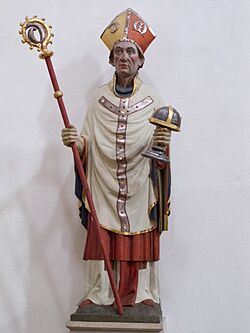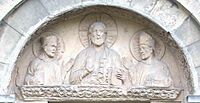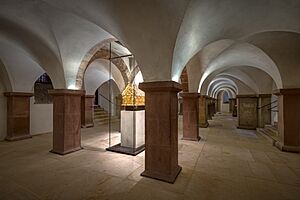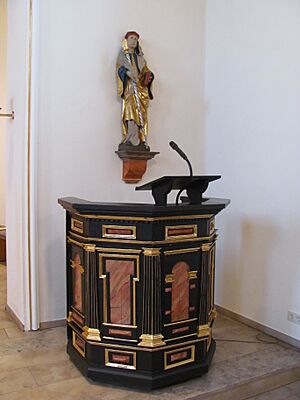Gotthard of Hildesheim facts for kids
Quick facts for kids SaintGotthard |
|
|---|---|

St. Gotthard as bishop, with the Hildesheim St. Mary relic receptacle; Basilica St. Godehard, Hildesheim
|
|
| Born | 960 Reichersdorf, Bavaria |
| Died | 5 May 1038 |
| Venerated in | Roman Catholic Church Eastern Orthodox Church |
| Canonized | 1131, Rheims by Pope Innocent II |
| Feast | 5 May |
| Attributes | dragon; model of a church |
| Patronage | travelling merchants; invoked against fever, dropsy, childhood sicknesses, hailstones, the pain of childbirth, and gout; invoked by those in peril of the sea |
Gotthard (also known as Godehard) was a German bishop who lived from 960 to 1038 AD. He is honored as a saint in the Christian church. People also called him Gothard or Godehard the Bishop.
Contents
Who Was Saint Gotthard?
Gotthard was born in 960 near a place called Niederalteich in Germany. His father, Ratmund, worked for the church leaders at Niederaltaich Abbey. Gotthard studied many subjects there, including history and religion.
Early Life and Education
While at Niederaltaich Abbey, Gotthard became a canon, which is a type of priest. He then continued his studies in Salzburg, where he helped manage church affairs. Gotthard traveled to different countries, including Italy. He finished his advanced studies in Passau. After his studies, he returned to Niederaltaich and became a provost, a senior church official.
Becoming a Monk and Abbot
In 990, Gotthard became a Benedictine monk at Niederaltaich. This happened when Henry II of Bavaria decided to change the church house into a monastery. In 993, Gotthard became a priest. Later, he became the prior (second-in-command) and led the monastery's school. In 996, he was made the abbot, which is the head of a monastery.
Reforming Monasteries
Gotthard was very dedicated to making changes and improvements. He brought the Cluniac reforms to Niederaltaich. These reforms helped bring back the strict rules of the Rule of St. Benedict, which guided how monks should live. He also trained other abbots to help improve monasteries like Tegernsee, Hersfeld, and Kremsmünster. This work was supported by Henry II, Holy Roman Emperor.
Bishop of Hildesheim
In 1022, Gotthard became the bishop of Hildesheim. He took over from another important bishop named Bernward. Gotthard was consecrated by Aribo, Archbishop of Mainz. For 15 years, he led the church in Hildesheim. He was highly respected by the clergy, who are church officials.
Focus on Education and Building
Gotthard cared a lot about educating young clergy members. He started several schools to help them learn. The cathedral school in Hildesheim became a very important learning center because of him. Gotthard also ordered the building of about 30 churches. He founded a monastery and had a church built there, which was dedicated to Saint Maurice. This church was consecrated in 1028.
His Final Years
Even when he was old, Gotthard strongly defended the rights of his diocese. He became sick for a short time and passed away on 5 May 1038. He died at a hospice (a place for travelers) that he had founded.
How Saint Gotthard is Honored

After Gotthard died, the bishops who came after him in Hildesheim wanted him to be made a saint. These were Bertold (1119–30) and Bernhard I (1130–53).
Becoming a Saint
Gotthard was officially made a saint in 1131. This happened at a special meeting called a synod in Rheims. Pope Innocent II declared Gotthard a saint. Bishop Bernhard and Norbert of Xanten were present at this important event.
Moving His Relics
On May 4, 1132, Bishop Bernhard moved Gotthard's relics (his remains) from the abbey church to the main cathedral in Hildesheim. The next day, May 5, was the first time a special church celebration was held in Gotthard's honor. People believed that Miracles happened because of his relics. The shrine where Gotthard's relics are kept is one of the oldest from the Middle Ages, made around 1140.

Widespread Veneration
People started to honor Gotthard in many places, including Scandinavia, Switzerland, and Eastern Europe. He was often prayed to for help with fevers, dropsy (a swelling illness), childhood sicknesses, hailstones, pain during childbirth, and gout (a type of arthritis).
Patron Saint of Travelers
Gotthard also became known as the patron saint of traveling merchants. Because of this, many churches and chapels in the Alps mountains were named after him.
The Niederaltaich Abbey named its famous grammar school after him, calling it the St.-Gotthard-Gymnasium.
The St. Gotthard Pass
There is a famous mountain pass in the Swiss Alps called the St. Gotthard Pass. An old story says that a small church there was founded by Galdino, who was the Archbishop of Milan from 1166 to 1176. Another story says it was founded by Enrico da Settala, Bishop of Milan from 1213 to 1230. A hospice (a place for travelers) at the pass was later cared for by the Capuchin Order.
Places Named After Saint Gotthard
Many places and events are named in honor of Saint Gotthard:
- Gothard is a common last name.
- The St Gotthard Pass in Switzerland connects different parts of the country.
- Szentgotthárd Abbey is a monastery in Hungary.
- Szentgotthárd is a town in Hungary.
- The Battle of Saint Gotthard (1664) was a battle during the Austro-Turkish war.
- The Battle of Saint Gotthard (1705) was part of a rebellion against the Habsburg rulers.
See also
- List of Catholic saints
Images for kids
-
Tympanum depicting Christ, Gotthard and Epiphanius. Hildesheim, St. Godehard Basilica.
-
Shrine of Godehard in the crypt of Hildesheim Cathedral






